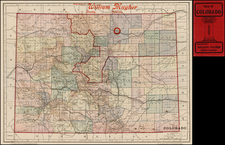Red Mountain Mining District -- Ouray County, Colorado
Nice example of W.A. Sherman's extremely rare promotional map showing the Red Mountain Mining District, in Ouray County, Colorado.
Oriented with Northwest at the top. The map follows the course of the Silverton Railroad, from the Summit Depot Grounds, through the Town of Red Mountain (now a Ghost Town), and on to just beyond the Town of Ironton (now a Ghost Town), generally following the same course as the county road to Ouray. Several Railroad Depots are noted along the way.
The map provides a detailed look at the mining claims in the Red Mountain Mining District, showing First Red Mountain, Second Red Mountain, Third Red Mountain, Brown Mountain, Hayden Mountain, and Commodore Gulch, along with a number of the smaller gulches and creeks. At the end of the Railroad Line, the Park Placer, Ouray Placer and Red Mountain Placer areas are shown along Red Mountain Creek, Full Moon Creek, and Hendrick's Creek.
W.A. Sherman prepared 2 maps of the Red Mountain Mining District, both of which are extremely rare. The first, prepared in 1886 by Mills & Sherman, shows significantly less detail (OCLC locates 3 examples). This second map, prepared in 1891 and printed by Rand McNally (no examples in OCLC), shows considerably more information and mining claims, as well as the extension of the the Silverton Railroad to Ironton and beyond and the Ironton Depot, which was constructed in 1889. It is also perhaps the only obtainable map to show the second Ironton townsite, before it was destroyed by fire for the first time in 1892.
The Red Mountain Mining District in the San Juan Mountains of southwestern Colorado was the scene of the second largest Colorado Silver Rush, second only to that of Leadville. In a period of less than 25 years, more than $30,000,000 in silver, lead, zinc, copper, and gold were taken from the rich deposits in the mines along Red Mountain Divide.
The Red Mountain Mining District was prospected as early as September of 1879. As the miners made their way up Mineral Creek, north of Silverton, they found deposits of gold, silver, lead, and copper. The Red Mountain Mining District, on both the north and south sides of Red Mountain (Sheridan) Pass, was the most prolific in the area. In 1881, John Robinson discovered the fabulously rich Yankee Girl and Guston Mines. These two mines were located just above a broad mountain valley, called Ironton Park, which is in the north end of the district. Ironton was established in 1883, and platted on March 20, 1884.
The road from Red Mountain Pass to Ouray was started by the Ouray & San Juan Wagon Road Company on April 1, 1880. Progress on the road was made in 1880, and 1881 but by 1882, the company was running out of money. After several attempts to reorganize, Otto Mears purchased a 54 percent interest in the toll road company and organized a larger and well-financed construction crew to complete the road.
Originally called Copper Glen, Ironton was first settled in 1883 as a supply point for the mines in the Red Mountain Mining District. The town became one of the largest in the district, with an 1890 population in excess of 300 and a variety of businesses such as hotels, saloons, restaurants and several mercantiles. The Silverton Railroad reached Ironton in 1889 and a depot was constructed at a cost of $2,500.
Over the years several fires damaged the town, which was in decline by the turn of the last century, largely because of the silver crash of 1893. By 1910 the population was down to 48 people. The last inhabitants, Harry and Milton Larson worked and lived in Ironton starting in the 1920s. Harry died in the 1940's, but Milton continued to live alone in the town of Ironton until his death in the mid-1960s.
The discovery of the silver-rich ore at the Yankee Girl and other mines led to the creation of Red Mountain Town in early 1883. Snow concealed the swampy nature of the first townsite, so in 1885, it was moved north to firmer ground near the National Belle Mine. The town had several businesses and 500 residents. Otto Mears' Silverton Railroad arrived on September 19, 1888. The town burned in 1892, was rebuilt, burned again three years later, and was partially rebuilt. After a short economic resurgence in 1907, the population dwindled to twenty-six by 1910, and the post office closed in 1913. A 1939 forest fire destroyed most of what remained. The jail is the only remaining structure still standing in Red Mountain Town.









![[Austins Colony] Mexico & Guatemala](https://storage.googleapis.com/raremaps/img/small/94054.jpg)

![Colton's United States of America [State of Colona named]](https://storage.googleapis.com/raremaps/img/small/90086.jpg)

![Map showing territorial growth of the City of Denver [and] Map of Denver, Auraria & Highland Townsites and present corporate limits of the City of Denver](https://storage.googleapis.com/raremaps/img/small/83393.jpg)
![Nouvelle Carte Du Mexique, Du Texas Et D'Une Partie Des Etats Limitrophes . . . 1840 [Proposed Railroads In Texas -- First Appearance of Arizona on a Printed Map]](https://storage.googleapis.com/raremaps/img/small/103480.jpg)